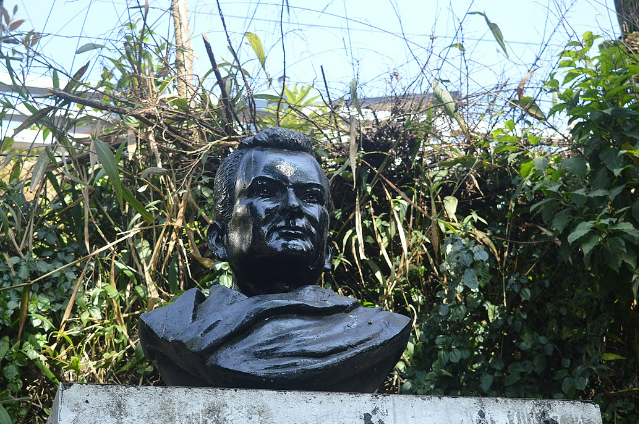9th April, on the birth anniversary of Rahul Sankrityayan...let's remember this literary artist, and let's channelize our energy and revitalise our steps in the pearls of words.
Rahul Sankrityayan ( 1893 - 1963 ) was a traveler and literary polymath who has been referred as the 'father of Hindi travel literature'. He had varied interests and cannot be like categorized into one. He is the one who played a significant role in like theorizing the travel experiences. He is one of the most widely travelled scholars of India spending 45 years of his life on travels away from home. Travelled many places and wrote travelogues around in the same number. He gave authentic descriptions of travel experiences. His one such travelogue is 'Meri Laddakh Yatra' attends to the regional, geographical and cultural aspects of that region. He became a Buddhist monk and eventually worked on lines of Marxian Socialism. He was also an Indian nationalist and had been convicted for around three years for writing seditious writings against the British government. He is referred as a 'Great Scholar' of his times. He had unparalleled love for literature and languages. He had been awarded the civilian honour of 'Padma Bhushan' in 1963 by the Independent Government of India.
Initially, he was a follower of Arya Samaj founder by Swami Dayanand Saraswati. Later, he adopted Buddhism and that brought out a turning point in his life. He lost faith in the existence of God but still believed in the principle of reincarnation. Later, after coming into line with Marxian ideology, he rejected concepts of incarnation and afterlife. The two volumes of Darshan-Digdarshan which was a collected history of World's Philosophy.
His travels like took him to different parts of India including, Ladakh, Kashmir and Kinnaur. He also travelled to other countries such as Nepal, Tibet, Sri Lanka and Soviet Union. He spent several years in the Saran district in Bihar. The entry gate of the village is now known as 'Rahul Gate'. He mostly used surface transport to commute from one place to another. He led secret expeditions to many countries too. He entered Tibet as a Buddhist monk and made several trips to Tibet and brought valuable scripts in Pali and Sanskrit language back to India. Earlier in history, these were part of Vikramshila and Nalanda Universities. These objects were taken to Tibet at the time of invasion in the country during the Medieval period. Many universities were destroyed. Literary texts, documents and books were all burnt. Some say that he employed several mules to bring back these things to India. Museum in Patna lends special honour to the study of these materials.
He was also well-versed in several languages such as Hindi, Sanskrit, Pali, Bhojpuri, Sinhalese, French and Russian so and so forth. He basically promoted the development of Indological Studies. Creativity in his writing style was each time reflected in his work. Started writing during his twenties and his work is largely inter-disciplinary or covering myriads of disciplines such as history, philosophy, lexicography, folklore, science, drama and politics. His several works remain unpublished. He translated many types of work.
One of his most famous work in Hindi is 'Volga Se Ganga' (A journey from the Volga to the Ganges) - it is a historical fiction concerning the migration of Aryans from the Eurasian lands to their movements around Hindukush and the Himalayas and the sub-Himalayan regions and their spread to the Indo-Gangetic plains of Indian subcontinent. The book begins from 6000 BC and ends in 1942, the year when Quit India Movement call was given by Mahatma Gandhi. The book was published in the same year. A translation of this book has been done into English by Victor Kiernan was published in 1947 as 'From Volga to Ganga.' The Tamil, Telugu and Kannada translations of the book are also available. It continues to be one of the most influential books of all times.
His significant travelogue literature are- 'Tibbat me Sava Varsha, Meri Europe Yatra, Asia ke Durgam bhukhando mein, Yatra ke panne and Kinnar Desh Mein. More than ten of his books have been translated into the Bengali language. He also received the Sahitya Akademi Award in 1958 for his book Madhya Asia ka Itihaas.
He maintained diaries in Sanskrit which he extensively used at the time of construction of his autobiography. Being a polygot, he never used complex vocabulary difficult for a common man to understand. Wrote books on diverse and varied interest.
Historian Kashi Prasad Jayaswal compared Rahul Sankrityan with Buddha. Rahul's personality has left an indelible impression and his achievements speak much of him. He traveled widely and wrote in five languages- Hindi, Sanskrit, Bhojpuri, Pali and Tibetan. Covered books on various genres, style, taste and interest.
Remembering personalities like him in an age where readership is not that huge. The art of writing has been lost somewhere. Tourism and travel which are not much recognised get their expected status as they should have been. People are now reviving the skill of writing and the testimony to that is the remembrance of the 'Father of Hindi Travel Literature'.
. . .
Reference:
- kavishala.in

